The International Commission on Nobility and Royalty | home
The Imperial Family of Brazil
The following article is by Astrid Bodstein on the imperial family of Brazil: 
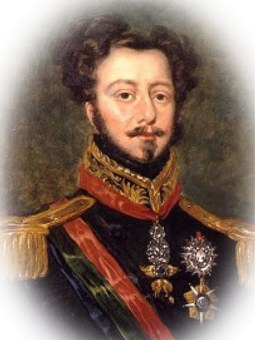 The Imperial Family of Brazil is known in its own country to republicans, to the media, to intellectuals and to the population in general but overseas, apart from those with a specialist interest in monarchy only few know the saga of this unique South American Dynasty.
The Imperial Family of Brazil is known in its own country to republicans, to the media, to intellectuals and to the population in general but overseas, apart from those with a specialist interest in monarchy only few know the saga of this unique South American Dynasty.
If Prince Pedro Gastão of Orleans and Bragança, Head of the Imperial Family of Brazil, is asked why and how Brazil became a Empire he sums up with humor the history of this dynasty, unique in South America: "It was due to Napoleon that everything happened. The Royal Family of Portugal came to Brazil in 1808 because of the Napoleonic invasions in the peninsula and that was the origin of the Brazilian branch of the House of Bragança. Queen Mary I and her son, the Regent Prince João (the future João VI), were the first crowned heads to set foot in the American continent ".
It was the expected arrival of Marshal Junot and his troops in Lisbon which prompted the decision to transfer the Royal Family, the court and the treasure of the Portuguese Crown to their territories overseas in Brazil. Ten thousand people embarked on 20 ships which weighed anchor on November 29th 1807. Junot arrived just in time to see the Portuguese fleet sailing away. Fortunately, the winds helped and the crossing was achieved: the ships arrived in the Port of Rio de Janeiro on March 7th 1808. The Brazilian adventure had started.
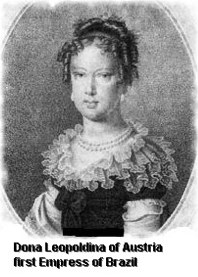 The Portuguese Court established the seat of the monarchy in the city of Rio de Janeiro and because of this, Rio became the capital of what was afterwards named the United Kingdom of Portugal, Brazil and Algarves. At that time Maria I (1734-1816) ruled. When she died, Regent Prince João (1767-1826) was proclaimed the new King of this United Kingdom. King João VI stayed in Brazil until 1821 and then returned to Portugal with his wife - the Spanish Infanta Carlota Joaquina de Borbón (1798- 1834) - and other members of the Royal Family. But the Crown Prince, Pedro of Bragança and Borbón (1798 - 1834), remained in Brazil as his father's regent and would soon separate the ancient South America colony from its European motherland.
The Portuguese Court established the seat of the monarchy in the city of Rio de Janeiro and because of this, Rio became the capital of what was afterwards named the United Kingdom of Portugal, Brazil and Algarves. At that time Maria I (1734-1816) ruled. When she died, Regent Prince João (1767-1826) was proclaimed the new King of this United Kingdom. King João VI stayed in Brazil until 1821 and then returned to Portugal with his wife - the Spanish Infanta Carlota Joaquina de Borbón (1798- 1834) - and other members of the Royal Family. But the Crown Prince, Pedro of Bragança and Borbón (1798 - 1834), remained in Brazil as his father's regent and would soon separate the ancient South America colony from its European motherland.
During his government, the Crown Prince Pedro defended the independence of his new homeland with enthusiasm. He identified himself with the popular will and with the support of his wife (Archduchess Leopoldina of Hapsburg, 1797-1826), he proclaimed Brazilian Independence on September 7th 1822. On October 12th he was proclaimed perpetual Emperor and Defender of Brazil and with the title Emperor Pedro I.
Pedro was liberal but authoritative as well. He recognized the importance of his country and gave it a social and political organization through the Imperial Constitution of 1824, which was responsible for Brazil's progress, wealth and stability. He was very popular and was considered the creator of the new independent state, and his liveliness and courage ensured the stability of his government during the first part of his reign.
When his father King João VI of Portugal died in 1826, Emperor Pedro I became the King Pedro IV of Portugal but in order to protect the independence of Brazil he resigned the Portuguese Crown in favor of his daughter Maria II (1819 - 1853). He kept the Brazilian Crown for himself and his son.
Pedro I was a great admirer of Napoleon and he was delighted to marry Archduchess Leopoldina of Hapsburg, whose sister Marie Louise was the French Emperor's second wife. Three years after Leopoldina died he was married again, this time to Princess Amélie of Leuchtenberg, the granddaughter of Napoleon's first wife, Joséphine. Pedro I reigned until 1831 when his Liberal enemies provoked unrest all over the country: then he resigned the Brazilian Crown in favor of his only legitimate son, Crown Prince Pedro (1825-1891), who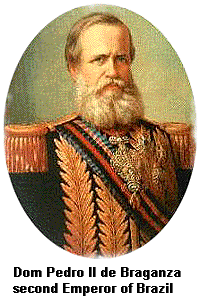 became Emperor Pedro II. Pedro I returned to Portugal, taking the title Duke of Bragança. He defended his daughter , the young Queen Maria II) from a rebellion commanded by Prince Miguel (1802 - 1866), his youngest brother, who had assumed the throne in 1828 and was only finally defeated after three years of civil war. Pedro I became regent for his daughter in May 1834 but died only months later, on September 24th in the Palace of Queluz, in the room where he was born.
became Emperor Pedro II. Pedro I returned to Portugal, taking the title Duke of Bragança. He defended his daughter , the young Queen Maria II) from a rebellion commanded by Prince Miguel (1802 - 1866), his youngest brother, who had assumed the throne in 1828 and was only finally defeated after three years of civil war. Pedro I became regent for his daughter in May 1834 but died only months later, on September 24th in the Palace of Queluz, in the room where he was born.
Emperor Pedro II, his son, was considered " the greatest Brazilian". According to the old Benedictine monk who brought him up he was a true guardian of the people. He was tolerant and fair, and during his reign, which lasted almost 50 years, Brazil was the first country after England to use postage stamps and to have a telephone system installed. Pedro II also encouraged the development of the railway. In his reign, Brazil had one of the biggest fleets in the world. Because of his progressive and intelligent grasp of politics, he was able to legitimize Brazilian power all over the South American continent.
From 1871 onwards Pedro II and his wife visited Europe many times to collect information which would help to improve the standard of living and to promote social equality among his subjects. He knew that his main function was to be a constitutional sovereign, to keep his obligations and above all to support the stability of the Brazilian Parliament. In 1876 the Emperor visited America. He went back to Europe in 1877 and spent the whole year there. During his long absences, Crown Princess Isabel (1846-1921), his daughter, was nominated Regent of the Brazilian Empire. While ruling in her father's place, she signed a law which put an end to the slavery in the Brazilian Empire. This act was signed in the "Palace of the City ", in Rio de Janeiro on May 13th 1888 and it was called the "Aurea Law ". As a result of it, the Princess was called "The Redemptress" and she received from Vatican the famous "Golden Rose", an honor given by the Pope to women for great humanitarian acts. The Emperor, returning to Brazil on August 22nd 1888, approved her action though he is said to have thought it rather precipitate. His only comment was: "Great people, great people".
Pedro II was dethroned in the following year by a republican coup d'état commanded by the Army and supported by the landowning aristocracy who blamed him for the end of the slavery. The Royal Family left Brazil on November 17th 1889, two days after the coup that proclaimed the Republic. The Emperor left without formally abdicating, in the ship Alagoas, which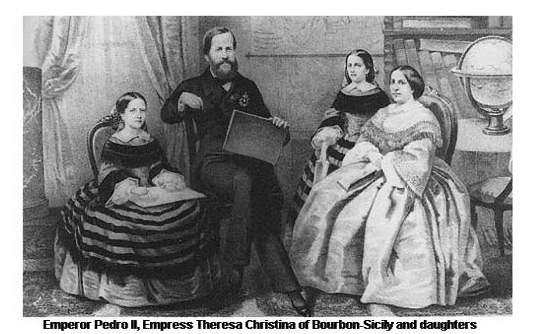 belonged to the Brazilian Navy. As soon as the President of Venezuela heard of the deposition he said: "They destroyed the only democracy in America."
belonged to the Brazilian Navy. As soon as the President of Venezuela heard of the deposition he said: "They destroyed the only democracy in America."
Pedro arrived in Lisbon on December 7th, accompanied by the Empress Thereza Christina, Imperial Princess Isabel, his son-in-law, Prince Gastão of Orleans, Count d'Eu, his grandchildren and some of the members of his Court who would not abandon him. As he did not want to disturb the crowning of his great-grandson, the new King Carlos I of Portugal (1863 - 1908), the Emperor left for Paris where he died from an illness on December 5th 1891, surrounded by admiration and respect from the whole world. The Republican French Government accorded him the honor of a state funeral. To pay homage to him, a great number of European members of the Gotha gathered in Paris, headed by his cousin and friend, (also deposed), Queen Isabel II of Spain (1830-1904), along with her daughter the Infanta Eulália (1864-1958).
Pedro II is part of the Brazilian history and is known as the "Magnanimous Emperor". His elder daughter Princess Isabel headed the Dynasty after him and from time of his death European Royalty and Brazilian monarchists regarded her as the Empress "de jure".
Isabel I of Brazil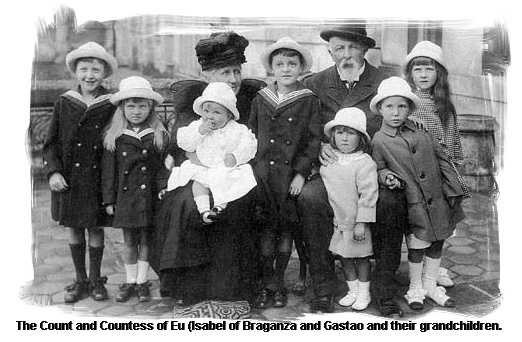
Born on 29th July 1846 in the Imperial Palace of Rio de Janeiro, Isabel was the second daughter of Pedro II of Bragança and Thereza Christina of Bourbon Sicilia. She was declared Crown Princess after her oldest brother, Prince Afonso (1845 - 1847), died, and the Emperor personally supervised her education.
Isabel was married on October 15th 1864 to Prince Gaston of Orleans (1842-1922), who was the son of the Duke of Nemours and grandson of Louis Philippe, King of the French. On the wedding day he became Prince of Brazil, with the style Imperial Highness.
Isabel was head of the Imperial Family of Brazil until her death in 1921 by the time she died. The children of her marriage to Prince Gaston and their descendants became the senior line of the Imperial Family, which is nowadays divided into two sub-groups. Her sister Leopoldina's marriage to Prince August of Saxe-Coburg-Gotha (1845-1907) originated the junior line, the `Saxe-Coburgo e Bragança'.
The descendants of the last Emperor of Brazil, Pedro II, made dynastic marriages with the royal families of France, Portugal, the Two-Sicilies, Austria, Bavaria and Yugoslavia and in this way the blood of the Brazilian Braganças was brought into the European Gotha.
So Brazil does have an Imperial Family. According to a Brazilian monarchist joke: "Thanks to the Braganças, Brazil, which has no snow, has its princes and princess" - who also won a permanent place for themselves in the worldwide picture of royalty.
[Based on the French historian and genealogist Philippe de Montjouvent: "Sovereign Dynasty, cited in the first part of the Almanach de Gotha . Catholic, the Imperial comes from the House of Bragança through Pedro de Bragança - King of Portugal and Emperor of Brazil ."]
Titles of the Imperial Family of Brazil
According to the Imperial Constitution of 1824:
- The Emperor is styled Imperial Majesty;
- The Crown Prince had the title of Imperial Prince and was styled Imperial Highness;
- The eldest of the Imperial Princes had the title of Prince of Grand-Pará, and was also styled Imperial Highness;
- All other princes of the dynasty were only Highness.
In 1909, the members of the elder branch of the Imperial Family (the Orleans and Bragança) signed an agreement with the Head of Royal Family of France, at that time the Duke of Orleans (1869-1926), called the "family pact". By this agreement, all of them were counted in the French line of succession, being properly styled Royal Highness. Therefore, from that agreement, the titles of the members of the Imperial Family of Brazil changed as follows:
- Prince Pedro Gastão (Head of the Dynasty and Prince of Brazil); Prince Pedro Carlos (Imperial Prince) and Prince Pedro Thiago of Orleans and Bragança (Prince of Grand-Pará), Imperial and Royal Highness;
- Other princes of the eldest branch, princes of Orleans and Bragança styled Royal Highness;
- Members of the junior branch hold the title Prince of Saxe-Coburgo e Bragança with the style Highness.
Is there a dynastic question?
In Portugal, where the Imperial Family of Brazil originated, there is a proverb in the Royal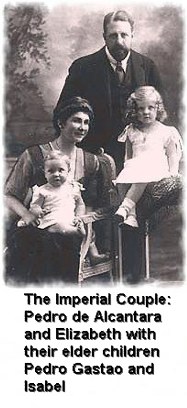 House which was transferred to the Brazilian Dynasty: "The King makes a commoner Queen" As in France, the marriages of the princes of the dynasty can only be done with the agreement and acceptance of the Emperor. If there is no Emperor at the time the marriage is supposed to take place, it cannot take place without the permission of the National Assembly.
House which was transferred to the Brazilian Dynasty: "The King makes a commoner Queen" As in France, the marriages of the princes of the dynasty can only be done with the agreement and acceptance of the Emperor. If there is no Emperor at the time the marriage is supposed to take place, it cannot take place without the permission of the National Assembly.
In 1908 Prince Pedro de Alcântara of Orleans and Bragança, the eldest son and heir of Princess Isabel, wanted to marry Countess Elisabeth Dobržensky von Dobrženicz. At that time the National Assembly of Brazil, which had been a republic since 1889, could no longer decide on imperial marriages. He therefore signed an act abdicating the Crown of Brazil, with no explanations. This document was signed with Princess Isabel as witness in Cannes on October 30th 1908. It is rumored among members of the family that Pedro de Alcântara was influenced by his youngest brother, Prince Luíz, who married Princess Maria Pia of Bourbon-Sicilia on November 4th 1908.
When Princess Isabel died in 1921 her eldest son should have been the Head of the Dynasty. It was, however, her grandson Pedro Henrique, Prince Luiz's son, that had that position and became Head of the Imperial Family of Brazil. The Monarchist Directory complained and issued an statement saying that the heir should be the eldest son of the late Princess.
A few years before he died, Prince Pedro de Alcântara said to a Brazilian newspaper: "My resignation was not valid for many reasons: besides, it was not a hereditary resignation." So when he died in 1940 his eldest son, Prince Pedro Gastão, decided to regain his legitimate position as the Head of Imperial Family of Brazil. He was supported by his brothers-in-law, the Duke of Calabria (Head of the Two-Siciles Royal Family) and the Count of Barcelona (Head of the Royal Family of Spain).
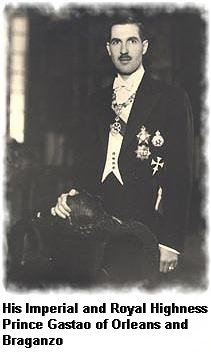 At that time, his cousin Pedro Henrique contested his right to be Head of the Dynasty. After Pedro Henrique's death, his son took up the cause. In Europe the resignation of Pedro de Alcântara had been accepted and after 1921 many royal families recognized his nephew Pedro Henrique as the Head of Family. In Brazil the decisions taken were different, however; in the 40's, the professor of the faculty of Law from the University of São Paulo, Francisco Morato, concluded that the resignation in 1908 was not valid either as a legal act or a monarchical act. In the 90's another jurist, Paulo Napoleão Nogueira da Silva, published a report re-stating the invalidity of the resignation under all the possible aspects of the Brazilian Law. Some months later, he published the book, Monarchy: Truths and Lies.
At that time, his cousin Pedro Henrique contested his right to be Head of the Dynasty. After Pedro Henrique's death, his son took up the cause. In Europe the resignation of Pedro de Alcântara had been accepted and after 1921 many royal families recognized his nephew Pedro Henrique as the Head of Family. In Brazil the decisions taken were different, however; in the 40's, the professor of the faculty of Law from the University of São Paulo, Francisco Morato, concluded that the resignation in 1908 was not valid either as a legal act or a monarchical act. In the 90's another jurist, Paulo Napoleão Nogueira da Silva, published a report re-stating the invalidity of the resignation under all the possible aspects of the Brazilian Law. Some months later, he published the book, Monarchy: Truths and Lies.
When he was asked about this subject by the Brazilian magazine "Monarchical World", Pedro Gastão said: "My uncle Luiz and my cousin Pedro Henrique, and above all, my uncle, truly believed in his rights. After all, this question had never been thoroughly checked."
Nowadays, for millions of Brazilian monarchists the Prince Pedro Gastão is the legitimate heir of the Brazilian Emperors. It is worth remembering that the late Countess of Paris always called Pedro Gastão as: "My brother, the Brazilian Emperor".
(Note: As intimated above, there is another part of the family that claims to be the true heirs to the Imperial throne of Brazil, which claim may be more or less legitimate. It is not the policy of The International Commission on Nobility and Royalty to take sides on rival claims, unless required to do so, and the evidence is beyond reasonable doubt one way or the other. Hence no position has been taken. Both sides are listed on our "Royal Families of the World" page.
(Note also: HIRH the Prince Pedro Gastão passed away in late December of 2007. As we understand his son, Prince Dom Pedro Carlos of Orleans and Bragança has taken his place in claiming to be one of the two claimants to the Imperial throne.)
Other articles in this section:
Main articles written by the Commission:
For "Contact" information or to join the Commission as a contributor or apply for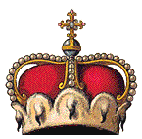 certification for titles, knighthood, status or ancestry, please first read the "Disclaimer and Obligatory Contract." If you fully agree with them, you are welcome to contact us, make contributions, answer our survey and/or become a part of this important cause. Our goals and mission are to protect the public from counterfeit titles, phony knighthoods and fake genealogies. We also want to certify the true and the genuine as well as promote chivalry, royalty and nobility. We need your support. There is so much that needs to be done. We invite you to contribute and join with us.
certification for titles, knighthood, status or ancestry, please first read the "Disclaimer and Obligatory Contract." If you fully agree with them, you are welcome to contact us, make contributions, answer our survey and/or become a part of this important cause. Our goals and mission are to protect the public from counterfeit titles, phony knighthoods and fake genealogies. We also want to certify the true and the genuine as well as promote chivalry, royalty and nobility. We need your support. There is so much that needs to be done. We invite you to contribute and join with us.
Contact or donate through the following:
© Copyright 2005/2009 -- International Commission on Nobility and Royalty. All Rights Reserved.
 The Imperial Family of Brazil is known in its own country to republicans, to the media, to intellectuals and to the population in general but overseas, apart from those with a specialist interest in monarchy only few know the saga of this unique South American Dynasty.
The Imperial Family of Brazil is known in its own country to republicans, to the media, to intellectuals and to the population in general but overseas, apart from those with a specialist interest in monarchy only few know the saga of this unique South American Dynasty. The Portuguese Court established the seat of the monarchy in the city of Rio de Janeiro and because of this, Rio became the capital of what was afterwards named the United Kingdom of Portugal, Brazil and Algarves. At that time Maria I (1734-1816) ruled. When she died, Regent Prince João (1767-1826) was proclaimed the new King of this United Kingdom. King João VI stayed in Brazil until 1821 and then returned to Portugal with his wife - the Spanish Infanta Carlota Joaquina de Borbón (1798- 1834) - and other members of the Royal Family. But the Crown Prince, Pedro of Bragança and Borbón (1798 - 1834), remained in Brazil as his father's regent and would soon separate the ancient South America colony from its European motherland.
The Portuguese Court established the seat of the monarchy in the city of Rio de Janeiro and because of this, Rio became the capital of what was afterwards named the United Kingdom of Portugal, Brazil and Algarves. At that time Maria I (1734-1816) ruled. When she died, Regent Prince João (1767-1826) was proclaimed the new King of this United Kingdom. King João VI stayed in Brazil until 1821 and then returned to Portugal with his wife - the Spanish Infanta Carlota Joaquina de Borbón (1798- 1834) - and other members of the Royal Family. But the Crown Prince, Pedro of Bragança and Borbón (1798 - 1834), remained in Brazil as his father's regent and would soon separate the ancient South America colony from its European motherland.  became Emperor Pedro II. Pedro I returned to Portugal, taking the title Duke of Bragança. He defended his daughter , the young Queen Maria II) from a rebellion commanded by Prince Miguel (1802 - 1866), his youngest brother, who had assumed the throne in 1828 and was only finally defeated after three years of civil war. Pedro I became regent for his daughter in May 1834 but died only months later, on September 24th in the Palace of Queluz, in the room where he was born.
became Emperor Pedro II. Pedro I returned to Portugal, taking the title Duke of Bragança. He defended his daughter , the young Queen Maria II) from a rebellion commanded by Prince Miguel (1802 - 1866), his youngest brother, who had assumed the throne in 1828 and was only finally defeated after three years of civil war. Pedro I became regent for his daughter in May 1834 but died only months later, on September 24th in the Palace of Queluz, in the room where he was born.  belonged to the Brazilian Navy. As soon as the President of Venezuela heard of the deposition he said: "They destroyed the only democracy in America."
belonged to the Brazilian Navy. As soon as the President of Venezuela heard of the deposition he said: "They destroyed the only democracy in America." 
 House which was transferred to the Brazilian Dynasty: "The King makes a commoner Queen" As in France, the marriages of the princes of the dynasty can only be done with the agreement and acceptance of the Emperor. If there is no Emperor at the time the marriage is supposed to take place, it cannot take place without the permission of the National Assembly.
House which was transferred to the Brazilian Dynasty: "The King makes a commoner Queen" As in France, the marriages of the princes of the dynasty can only be done with the agreement and acceptance of the Emperor. If there is no Emperor at the time the marriage is supposed to take place, it cannot take place without the permission of the National Assembly. At that time, his cousin Pedro Henrique contested his right to be Head of the Dynasty. After Pedro Henrique's death, his son took up the cause. In Europe the resignation of Pedro de Alcântara had been accepted and after 1921 many royal families recognized his nephew Pedro Henrique as the Head of Family. In Brazil the decisions taken were different, however; in the 40's, the professor of the faculty of Law from the University of São Paulo, Francisco Morato, concluded that the resignation in 1908 was not valid either as a legal act or a monarchical act. In the 90's another jurist, Paulo Napoleão Nogueira da Silva, published a report re-stating the invalidity of the resignation under all the possible aspects of the Brazilian Law. Some months later, he published the book, Monarchy: Truths and Lies.
At that time, his cousin Pedro Henrique contested his right to be Head of the Dynasty. After Pedro Henrique's death, his son took up the cause. In Europe the resignation of Pedro de Alcântara had been accepted and after 1921 many royal families recognized his nephew Pedro Henrique as the Head of Family. In Brazil the decisions taken were different, however; in the 40's, the professor of the faculty of Law from the University of São Paulo, Francisco Morato, concluded that the resignation in 1908 was not valid either as a legal act or a monarchical act. In the 90's another jurist, Paulo Napoleão Nogueira da Silva, published a report re-stating the invalidity of the resignation under all the possible aspects of the Brazilian Law. Some months later, he published the book, Monarchy: Truths and Lies.
 certification for titles, knighthood, status or ancestry, please first read the "Disclaimer and Obligatory Contract." If you fully agree with them, you are welcome to contact us, make contributions, answer our survey and/or become a part of this important cause. Our goals and mission are to protect the public from counterfeit titles, phony knighthoods and fake genealogies. We also want to certify the true and the genuine as well as promote chivalry, royalty and nobility. We need your support. There is so much that needs to be done. We invite you to contribute and join with us.
certification for titles, knighthood, status or ancestry, please first read the "Disclaimer and Obligatory Contract." If you fully agree with them, you are welcome to contact us, make contributions, answer our survey and/or become a part of this important cause. Our goals and mission are to protect the public from counterfeit titles, phony knighthoods and fake genealogies. We also want to certify the true and the genuine as well as promote chivalry, royalty and nobility. We need your support. There is so much that needs to be done. We invite you to contribute and join with us.
 For Membership or to become Certified, please read "Membership Categories, Fees, Evidence Requirements & Standards."
For Membership or to become Certified, please read "Membership Categories, Fees, Evidence Requirements & Standards."